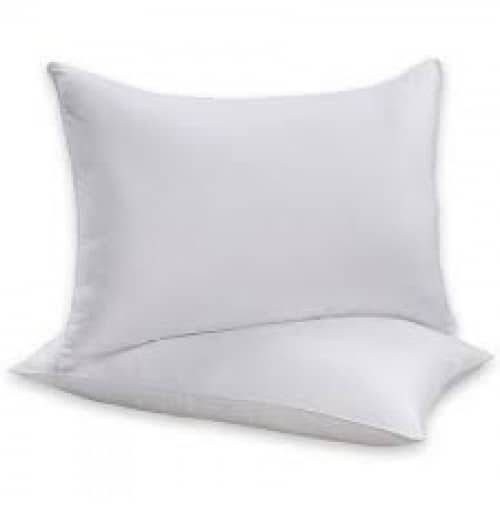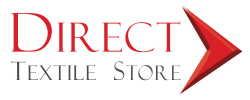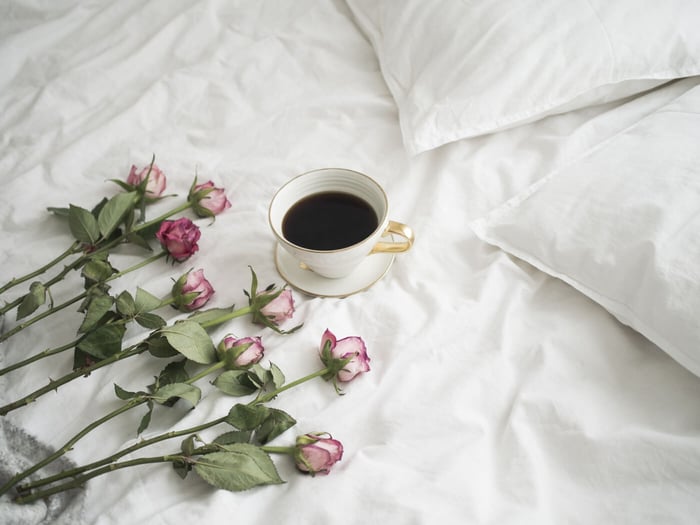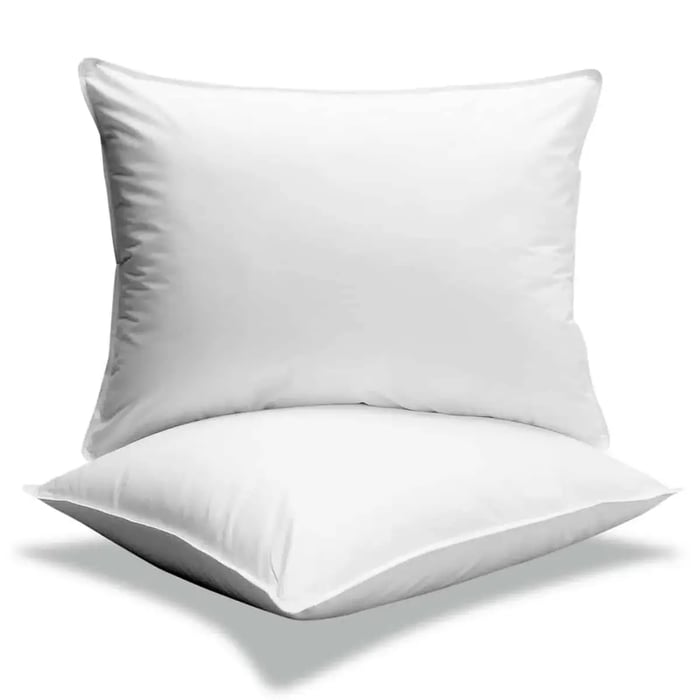Hotel guests often find a property’s pillows too soft or too firm; some, luckily, find them just right. In this post we'll review how to choose a hospitality pillow.
Of all the items purchased by a property’s linen buyer, wholesale pillows are one of the keys to guest comfort. After all, whether your property is a strict budget motel or a five-star vacation resort, the most fundamental item you are selling is a good night’s sleep. Next to the mattress and box spring, a good, clean, comfortable pillow is essential.

Pillow Terms
- Pillow Size: refers to the overall dimensions of the pillow, specified in inches, width X length. Note that the pillows are bought and sold by the finished size, but they are manufactured by the cut size, which is the size of the pillow shell before it is filled. A standard pillow is 20X26 finished, 21X27 cut. A queen pillow is 20X30 finished, 21X31 cut and a king pillow is 20X36 finished, 21X37 cut.
- Pillow Weight: refers to the weight of the contents of the pillow, specified in ounces.
- Pillow Fill: refers to the content or material inside the pillow.
- Pillow Tick: refers to the cover or outside of the pillow. A tick specification will include both its content (50/50 poly/cotton) and its thread count, specified in warp (vertical yarns) and weft (horizontal yarns), such as 76/56, which is the number of threads in a square inch.
- Pillow Edging: refers to the type of stitch used to close the pillow and join the seam together. Most institutional pillows have a surged overlock stitched edge, which is designed to withstand commercial use.

PILLOW SIZE
Your first decision in selecting a hotel brand pillowis to determine what size; standard, queen, or king, to order. Today, many properties are using standard pillows throughout their property: one on a twin, two on a full and queen, and three or four on a king.
The reason for using only standard size pillows is that it simplifies the pillow and pillow case inventory, eliminating additional stock keeping units. Additionally, some guests feel that even on a king bed, they prefer a standard pillow, as a king pillow will have a tendency for the sides to come up too close to the head when you lay in the middle of it. Obviously, this is purely a personal preference issue, and for every guest who prefers a standard pillow on king bed, there is probably one who wonders why they are not getting a king pillow.
Queen pillows are rarely purchased; they are less than 1% of hospitality pillow sales. Properties almost always use standard pillows on a queen bed.
PILLOW FILL
After size, the next consideration is the type of fill in the pillow. This can be quite confusing, as there are over 25 different fills actively marketed in the hospitality business, and they each come in a few versions.
To simplify the market, let us look at two broad categories: natural fiber and synthetic fiber. Natural fills include feather and down. Synthetic fiber is usually some form of polyester, urethane, or foam rubber.
A natural fiber pillow has a connotation of high-end luxury, and it is still the choice of many four and five star resorts, whose goal is to duplicate the experience that these high-end guests have at home. These pillows require a down proof tick, which has an extremely high thread count, to prevent a feather from poking out and touching a guest. Down comes in many different grades and qualities, and, the very best pillows may cost over $100.00 each wholesale.
Therefore, to keep costs reasonable for a hospitality property, manufacturers use a mix of down and feathers, and the content of down is extremely small. A popular natural fiver pillow is the 95/5 crushed feather/down. Which is 95% crushed feather and 5% down. Cost for this type of pillow is well under $10.00 each.
A potential problem with natural fiber pillows, and a reason that every property featuring natural fiber pillows on its bed must have synthetic fiber pillows available, is that natural fiber pillows may aggravate an individual’s allergies.
Synthetic fiber pillows are hypo-allergenic, meaning that it will not cause any problems with a person who is allergic to natural fiber. Direct Textile Supply offers apremium hypo allergenic pillow and a standard hypo allergenic pillow.
PILLOW WEIGHT
The weight of a pillow, always specified in ounces, varies by the level of firmness desired, and of course, by the pillow size. For the same type of pillow, a king size usually weighs about 10 to 12 ounces more than a standard size pillow. For this discussion, all weights will refer to a standard size pillow.
For economy and middle market properties, synthetic fiber pillows usually come with a 20-ounce fill and a firmer version of the same pillow is available with a 22-ounce fill.
DuPont, one of the largest manufacturers of pillow fibers, has minimum weight requirements for its pillows, and because of their popularity, the industry has come to equate their Hollofil II “Green Label” (20 oz) and “Gold Label” (22 oz) pillows as popular industry standards.
Please note that there are also pillows using 24 ounces of fill, and that one cannot simply assume the more fill, the better. You can certainly have a pillow to firm, especially for people who sleep on their backs. However, in a hospitality installation, a 22 or 24-ounce fill pillow will provide more support over a longer period of time. Also, the bed will look far more inviting with a plump pillow on it. When in doubt, choose the extra fill pillow. Just think, when was the last time you stayed at a property whose pillows were too plump?
PILLOW TICK
For most hospitality properties, the pillow tick is not a large issue. On a synthetic fiber pillow, it is usually a blend of cotton and polyester, very plain in appearance (often solid white), and constructed in a reasonable thread count to withstand commercial use. However, a natural fiber pillow requires a more costly, tighter woven tick to prevent the fill material from poking through the cover.
Many special ticks are available for special applications. These include fire retardant ticks (and, for that matter, fills) for prisons, hospitals, and other institutions, and special waterproof ticks for healthcare installations. Colorful or damask (tone on tone) ticks are more popular in retail markets, where often people base their purchase decision on the cover of the pillow…which they will cover up with a pillow case as soon as they get home.
Generally, a tick’s job is to not call attention to itself, be durable, and keep the insides of a pillow where it belongs…inside the pillow.
PILLOW PROTECTORS
Pillow protectors are a protective cover, usually made from material similar to a tick, which goes on the pillow before the pillowcase. It will help protect the pillow from soiling and stains. Also, pillow protectors are a great way to add an extra layer of sanitation and protection for your guest, and they will also extend the life of the pillow.
Pillow Encasements are an upgrade to the pillow protecter. a pillow encasement completely encloses your pillow to keep it free of bed bugs, dust mites and allergens. The premium pillow encasement is constructed from densely woven microfiber fabric that is laminated with a poly coating. It will protect against stains and spills and keeps your pillow free of bed bugs, dust mites and allergens
WASHING PILLOWS
While almost all synthetic fiber pillows are “washable,” by industry standards terms, most do not withstand repeated washings very well. The problem is that just a slight excess amount of heat in the washing process can bond the fibers together, which results in a flat, lumpy pillow. Also, with every washing, some of the silicone coating used to prevent the fibers from bunching up is washed away.
When a pillow is washed in a commercial washer, it is spun at a high rate of speed. The fiber is pushed to the ends of the pillow by centrifugal force. Then, in this state, the pillow is put in a commercial dryer, which can “cook” the pillow into two lumps in each side. If you must wash a pillow, it should be done on the gentlest cycle available, and drying should be complete for 60–120 minutes using a very low heat setting.
Wash pillow protectors, not the pillow, to enjoy the full life of the pillow you purchase.
If you need help ordering the right pillow feel free to call our customer service team 800.615.5822
About the Author
Haley Bridges, Marketing Assistant at Direct Textile Store
Haley Bridges has served as Marketing Assistant at Direct Textile Store, where she specializes in hospitality linens, uniforms, and bulk textile solutions. She works closely with hotels, restaurants, and healthcare facilities to match them with durable, high-quality products that balance both performance and value. Haley's expertise in textile sourcing and merchandising strategy helps businesses make confident purchasing decisions while staying ahead of industry trends.
If you need assistance, contact Direct Textile Store Customer Service at 800-615-5822

Direct Textile Store ships to all US states, including Alaska and Hawaii, US Territories, Canada, Puerto Rico, St. Thomas, and St. Croix.
Source: International Society of Hospitality Purchasers (ISHP)
Copy & Paste to Link to this Post!
<a href="https://directtextilestore.com/blog/how-to-choose-a-hospitality-pillow/">How to Choose a Hospitality Pillow</a>




